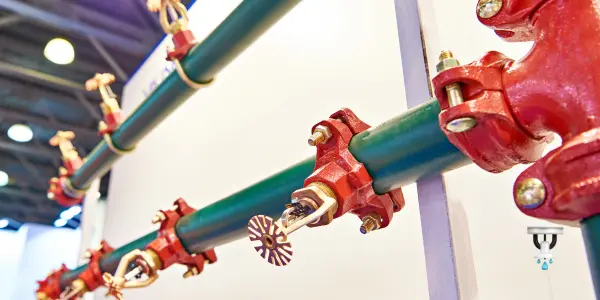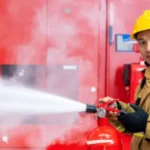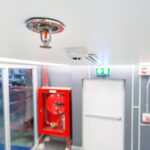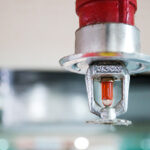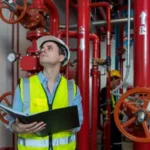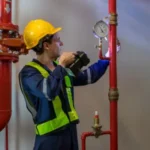Choosing the right fire sprinkler head types is an important process in designing a functional fire sprinkler system. Although they all have the same function, to discharge water when heat from fire is sensed, various types of sprinkler heads are made for different layouts, looks, and performance needs
In this guide, we will discuss the four most widespread fire sprinkler head styles: pendant, upright, sidewall, and concealed, detailing how each functions, where it’s ideally situated, and the exclusive advantages that it provides.
How Do Fire Sprinkler Heads Work?
Fundamentally, all sprinkler heads perform one job: they trigger when the heat of a fire hits a pre-set temperature. A glass bulb or fusible link is the trigger.
Glass bulb sprinklers employ a tiny liquid-filled, glycerin-based bulb. When temperature levels increase (usually 135°F to 200°F), the liquid gets enlarged until the bulb bursts, discharging water.
Fusible link sprinklers are dependent on metal components connected by a fire-sensitive alloy that melts and discharges the plug when exposed to fire, enabling water to flow.
Upon activation, water is forced out through an orifice and sprayed by a deflector to create a spray pattern suitable for the sprinkler’s orientation. Most fire sprinklers are designed to ½\” (K5.6) or ¾\” (K8.0) rated, with the bigger K-factors discharging more water for higher-hazard exposures.
Temperature Ratings and Response Types
Individual sprinklers are tested for responding at a specific temperature, ranging from 135°F to over 600°F, depending on their location. Glass bulbs are colored to indicate their rating, while fusible links use paint marks.
Sprinklers are also separated by response time:
Quick Response (QR): For residential occupancy, hotels, schools, and assembly occupancies. Respond more rapidly to extinguish flames and provide time to evacuate occupants.
Standard Response (SR): Generally used in warehouses and industrial settings, where the aim is to keep property damage low and control fire extension.
Four Main Fire Sprinkler Head Types
Pendent Sprinkler Head
The pendent sprinkler head is the most common of all fire sprinkler heads in modern fire sprinkler systems. It is installed in a position where the head will hang down from the ceiling. The head discharges water with a round spray pattern that covers the floor area below it.
Features
- Suspends down straight from overhead piping.
- The deflector plate distributes water in an overlapping circle for extensive coverage.
- Simple and effective for overall use.
Best Application
- Commercial and office spaces
- Schools and universities
- Shopping malls and retail outlets
- Multi-family residential buildings
Because of its extensive use, the pendent sprinkler head is effective in protecting spaces with standard ceilings. Though conspicuous, decorative covers can provide design for spaces where aesthetics matter.
Upright Sprinkler Head
The upright sprinkler head is mounted above the branch piping, with its face facing up. When it is activated, water sprays upwards into the deflector and rains down in a fan shape over the area to be protected.
Features
- Pipe mounted above with head facing up.
- The top plate deflector deflects the spray downwards.
- Withstands obstructions like beams, ducts, and shelving.
Best Applications
- Industrial factories
- Warehouses
- Parking garages
- Exposed structural areas
The upright sprinkler head is ideal for spaces where pendent sprinklers are unable to provide sufficient coverage, especially in structures with complex infrastructure or equipment that will interfere with the water supply.
Sidewall Sprinkler Head
The sidewall sprinkler head is designed to be installed on walls instead of ceilings. It distributes water in a half-circle and is an ideal choice for cramped spaces where ceiling-mounted devices may not be practical.
Features
- Installed horizontally on a wall.
- Deflector creates a semicircle spray throughout the room.
- Conserves ceiling space and provides intense protection.
Bes Applications
- Corridors and hallways
- Hotel rooms
- Small offices
- Residential apartments with decorative ceilings
A sidewall sprinkler head is especially useful in spaces where overhead sprinklers are not practical. While it protects smaller areas, it provides adequate fire protection in narrow or confined spaces.
Concealed Sprinkler Head
For owners who care about safety and aesthetics, the concealed sprinkler head is the choice. Concealed under a flat cover plate, these sprinkler heads are hidden until heat activates them.
Features
- Covered with an architectural flat plate that’s the same as the ceiling.
- On activation, the plate releases, and the sprinkler head falls down.
- Acts like a pendent sprinkler head but is discreet.
Best Applications
- Hotels, restaurants, and resorts
- Luxury residential buildings
- Office lobbies and conference areas
- Upscale commercial property
The concealed sprinkler head maintains the same fire-fighting quality as a pendent-style but adds a smooth, design-enhancing look. It is therefore the preferred option for properties where interior design takes center stage.
Fire Sprinkler Head Types Compared
Various sprinkler heads are designed for various environments. Your building’s design, fire code regulations, and aesthetic requirements determine the best choice.
- Pendent sprinkler head: Typical selection for broad coverage, ceiling-mounted.
- Upright sprinkler head: Placed over piping, great for obstructions or equipment-filled areas.
- Sidewall sprinkler head: Wall-mounted for limited rooms, corridors, or decorative ceilings.
- Concealed sprinkler head: Beauty solution concealed within a cover plate, ideal for contemporary interiors.
Factors to Consider When Choosing Types of Sprinkler Heads
To find the appropriate types of sprinkler heads for your building, take the following into consideration:
- Room Layout – Ceiling type, height, and obstructions.
- Space Function – Wide open warehouses, compared to narrow hallways, call for various sprinkler heads.
- Aesthetic Goals – Concealed sprinkler heads go with the décor, while pendent and upright heads are seen.
- Fire Safety Codes – Local fire and building codes dictate accepted fire sprinkler systems and installations.
- Maintenance – Accessible sprinkler heads, such as pendent or upright heads, are simpler to check for damage or blockage.
Role of Professional Installation
Whichever types of fire sprinkler heads are specified, professional installation is paramount. A qualified fire protection firm ensures fire sprinkler systems:
- Compliant with NFPA standards and local codes.
- Strategically placed for full coverage.
- Regularly inspected and maintained for reliable performance.
Sprinkler heads do appear small, but the impact in a crisis is enormous. The wrong type of installation or improper placement lowers the efficiency, and property and lives are endangered.
Conclusion
Fire sprinkler head styles, pendent, upright, sidewall, and concealed, each has a specific function guarding different types of spaces. The pendent sprinkler head is still the most ubiquitous and adaptable. The upright sprinkler head is best used in industrial or blocked-in applications. The sidewall sprinkler head is wonderful for hallways and small rooms, and the concealed sprinkler head provides security with flair.
When choosing the right types of sprinkler heads for your fire sprinkler systems, it’s best to consult with a professional fire protection company. Properly selected and installed sprinkler heads not only comply with safety codes but also provide true peace of mind, ensuring lives and property remain protected even in the event of a fire.
FAQs
Q1. How does a fire sprinkler head know to activate?
Sprinkler heads are triggered by a fire producing heat to a programmed temperature. A glass bulb containing liquid or a fusible metal link is melted or broken by the heat to open up and release water.
Q2. What is the difference between quick response and standard response sprinklers?
Quick-response sprinklers react faster, and therefore, they are ideal for use in residential, hotel, and school areas where life is at stake. Standard response sprinklers are common in warehouses and industrial buildings, with a greater focus on slowing down fire spread and protecting property.
Q3. Where are pendent sprinkler heads installed most often?
Pendent sprinklers are ideal for offices, schools, stores, and homes with standard ceilings, offering wide coverage and reliable fire protection.

